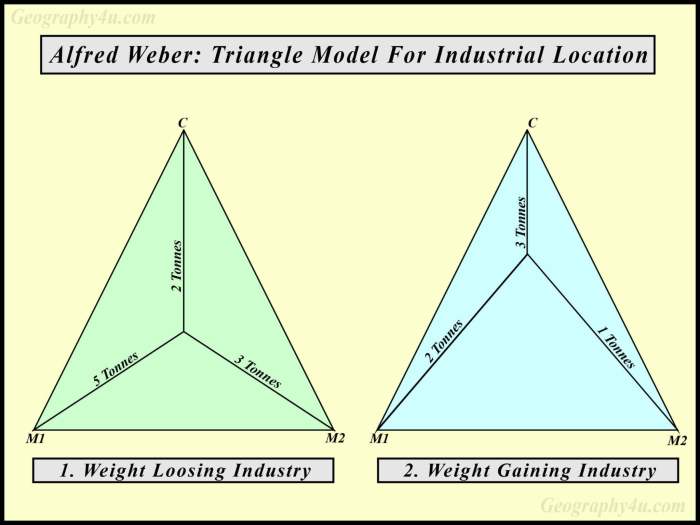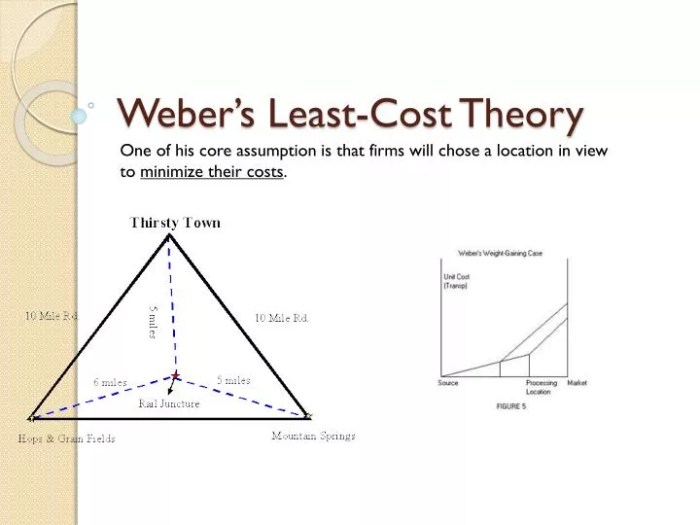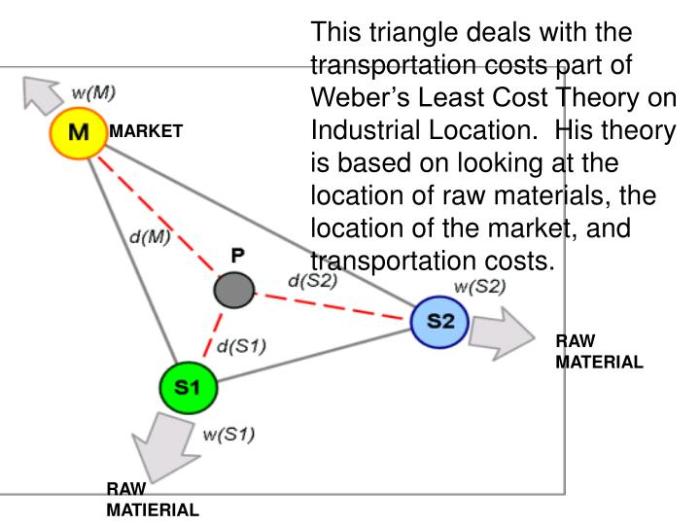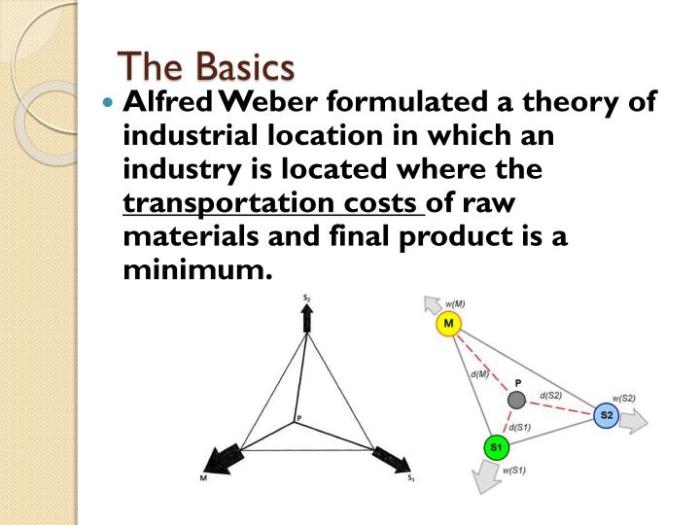Alfred weber least cost theory – Alfred Weber’s Least Cost Theory, a groundbreaking concept in economic geography, revolutionized the understanding of industrial location decisions. Its principles, assumptions, and applications have had a profound impact on businesses and researchers alike, making it a cornerstone of industrial location theory.
Weber’s theory provides a systematic framework for analyzing the factors that influence where industries locate, offering valuable insights for businesses seeking optimal locations to minimize costs and maximize profits.
Industrial Location Theory
Alfred Weber, a German economist, developed the least cost theory in 1909. It is a significant theory in economic geography that attempts to explain the location of industries. According to Weber, industries tend to locate in areas where they can minimize their total transportation costs, which include the cost of transporting raw materials to the factory and the cost of transporting finished products to the market.
Factors Influencing Industrial Location
Weber’s theory considers several factors that influence industrial location decisions, including:
-
-*Transportation costs
The cost of transporting raw materials and finished products is a critical factor in determining the location of an industry. Industries that rely on bulky or heavy raw materials or produce bulky or heavy finished products will tend to locate near their markets to minimize transportation costs.
-*Labor costs
The cost of labor is another important factor in industrial location decisions. Industries that require a large workforce will tend to locate in areas with a large and inexpensive labor pool.
-*Agglomeration economies
Agglomeration economies are the benefits that firms derive from locating near other firms in the same industry. These benefits can include access to specialized labor, suppliers, and customers, as well as the ability to share infrastructure and knowledge.
-*Government policies
Government policies, such as tax incentives and subsidies, can also influence industrial location decisions. Industries may choose to locate in areas where they can receive favorable treatment from the government.
Assumptions of Weber’s Least Cost Theory

Weber’s Least Cost Theory is based on several key assumptions that simplify the analysis of industrial location. These assumptions include:
Uniform and Isotropic Plain
Weber assumed that the production area is a uniform and isotropic plain, meaning that it has no physical barriers or variations in terrain that could affect transportation costs. This assumption simplifies the analysis by eliminating the influence of geographical features on location decisions.
Perfect Competition
Weber also assumed perfect competition in both the input and output markets. This means that there are many buyers and sellers, and no single firm has significant market power. Perfect competition ensures that firms can purchase inputs and sell outputs at the prevailing market prices, without being able to influence those prices.
Homogeneous Labor
Weber assumed that labor is homogeneous, meaning that all workers have the same skills and productivity. This assumption simplifies the analysis by eliminating the influence of labor quality on location decisions.
Single Market
Weber assumed that there is a single market for the firm’s output. This means that the firm can sell its products anywhere in the market at the same price. This assumption simplifies the analysis by eliminating the influence of market segmentation on location decisions.
No Transportation Costs for Raw Materials
Weber assumed that there are no transportation costs for raw materials. This means that the firm can purchase raw materials from any location without incurring any additional costs. This assumption simplifies the analysis by eliminating the influence of raw material transportation costs on location decisions.
Isodapanes and Isorithms
In Weber’s theory, isodapanes and isorithms are graphical tools used to determine the optimal location for an industry.
Isodapanes
Isodapanes are lines on a map that connect points with equal total transportation costs. They represent the boundaries of areas where the total transportation costs are the same for a given industry.
Isorithms
Isorithms are lines on a map that connect points with equal total production costs. They represent the boundaries of areas where the total production costs are the same for a given industry.
How Isodapanes and Isorithms Help Determine Optimal Location
The optimal location for an industry is the point where the isodapane and isorithm for that industry intersect. This point represents the location where the total transportation costs and the total production costs are both minimized.
Example
Consider an industry that produces furniture. The company is considering two possible locations: City A and City B. The total transportation costs for City A are $100,000, and the total production costs are $50,000. The total transportation costs for City B are $50,000, and the total production costs are $100,000. The isodapane for City A is a circle with a radius of 100 miles, and the isorithm for City A is a circle with a radius of 50 miles.
The isodapane for City B is a circle with a radius of 50 miles, and the isorithm for City B is a circle with a radius of 100 miles. The optimal location for the furniture company is the point where the isodapane and isorithm for City A intersect.
This point is located 50 miles from City A and 50 miles from City B.
Weber’s Triangle and Locational Triangle
Weber’s triangle is a graphical representation of the optimal location for an industry based on the transportation costs of raw materials and finished goods. It is a triangle with three vertices, each representing a different location. The industry is located at the point where the sum of the transportation costs from the three vertices is minimized.
The locational triangle is a similar concept, but it takes into account the costs of both transportation and production. The industry is located at the point where the sum of the transportation costs and the production costs is minimized.
Relationship between Weber’s Triangle and the Locational Triangle
Weber’s triangle is a special case of the locational triangle. When the production costs are constant at all locations, then the locational triangle is the same as Weber’s triangle.
Examples
Weber’s triangle can be used to determine the optimal location for a factory that produces goods from two different raw materials. The factory should be located at the point where the sum of the transportation costs from the two sources of raw materials is minimized.
The locational triangle can be used to determine the optimal location for a factory that produces goods from two different raw materials and has different production costs at different locations. The factory should be located at the point where the sum of the transportation costs and the production costs is minimized.
Alfred Weber’s least cost theory, which seeks to explain the location of industries based on transportation costs, has been widely applied in regional planning. However, its principles can also be applied to other areas of law, as evidenced by the Tyler v.
Wilkinson case brief . In this case, the court considered the impact of transportation costs on the location of a new business, ultimately ruling that the plaintiff’s choice of location was reasonable under Weber’s theory.
Criticisms and Limitations of Weber’s Least Cost Theory

Weber’s Least Cost Theory, while influential, has faced criticisms and limitations that have shaped the development of other industrial location theories. Its assumptions and simplifications, though useful for conceptualizing location decisions, may not accurately reflect real-world complexities.
Oversimplification of Transportation Costs
Weber’s theory assumes that transportation costs are the primary determinant of industrial location. However, in reality, other factors such as labor costs, market size, and government policies can also play significant roles.
Static Analysis
Weber’s theory assumes a static environment where transportation costs and other factors remain constant over time. However, in practice, these factors are often dynamic and can change rapidly, making it difficult to apply the theory in real-world situations.
Neglect of Agglomeration Economies
Weber’s theory does not consider the potential benefits of locating near other industries, known as agglomeration economies. These economies can arise from shared infrastructure, specialized labor markets, and knowledge spillovers, and can significantly influence industrial location decisions.
Inapplicability to Service Industries
Weber’s theory is primarily designed for manufacturing industries that involve the transportation of physical goods. It may not be as applicable to service industries, where transportation costs are less significant and other factors, such as customer proximity and access to skilled labor, become more important.
Applications of Weber’s Least Cost Theory

Weber’s Least Cost Theory finds practical applications in a wide range of industries, helping businesses optimize their location decisions to minimize transportation costs and maximize efficiency.
Manufacturing Industry
In manufacturing, Weber’s theory helps determine the optimal location for production facilities. By considering factors such as raw material sources, labor costs, and transportation expenses, businesses can identify locations that minimize overall production and distribution costs.
Retail Industry
Retailers use Weber’s theory to select store locations that maximize accessibility to customers while minimizing transportation costs. They consider population density, competition, and transportation infrastructure to find locations that provide the best balance of convenience and affordability.
Logistics and Distribution
Logistics companies use Weber’s theory to optimize their distribution networks. They analyze transportation costs, inventory levels, and customer demand to determine the best locations for warehouses and distribution centers.
Benefits of Using Weber’s Theory
- Reduces transportation costs
- Improves efficiency and productivity
- Provides a framework for informed decision-making
Challenges of Using Weber’s Theory
- Assumes fixed transportation costs
- May not account for all relevant factors (e.g., market demand)
- Can be complex and time-consuming to apply
Extensions and Modifications of Weber’s Theory

Weber’s Least Cost Theory has undergone several extensions and modifications by subsequent researchers to enhance its applicability and address its limitations. These modifications have expanded the theory’s scope and made it more adaptable to complex industrial scenarios.
Key Differences between Weber’s Original Theory and Its Modern Extensions
The key differences between Weber’s original theory and its modern extensions include:
- Incorporation of additional cost factors:Modern extensions consider a wider range of cost factors, such as labor costs, transportation costs, and raw material costs, to provide a more comprehensive analysis of industrial location.
- Relaxation of assumptions:The original theory assumed fixed transportation rates and isotropic (uniform) space. Modern extensions relax these assumptions, allowing for variable transportation rates and considering the impact of geographical factors on location decisions.
- Integration of quantitative techniques:Modern extensions incorporate quantitative techniques, such as linear programming and simulation, to optimize location decisions and account for uncertainties and complex decision-making processes.
Examples of Extensions, Alfred weber least cost theory
Some notable extensions of Weber’s theory include:
- Launhardt’s location theory:This extension incorporates variable transportation rates and considers the impact of raw material sources and markets on location decisions.
- Hotelling’s location theory:This extension focuses on the location of multiple firms in a market and considers the impact of competition on location decisions.
- Greenhut’s integrated location theory:This extension combines Weber’s theory with other location theories, such as the median voter theorem and the central place theory, to provide a comprehensive framework for industrial location analysis.
These extensions have significantly improved the applicability of Weber’s theory by making it more realistic, flexible, and adaptable to various industrial scenarios.
Essential FAQs: Alfred Weber Least Cost Theory
What are the key assumptions of Weber’s Least Cost Theory?
Weber’s theory assumes a uniform and isotropic plain, perfect competition, homogeneous labor, a single market, and no transportation costs for raw materials.
How do isodapanes and isorithms help determine optimal industrial locations?
Isodapanes represent lines of equal total transportation costs, while isorithms represent lines of equal production costs. The intersection of isodapanes and isorithms identifies locations with the lowest overall costs.
What are the limitations of Weber’s Least Cost Theory?
Weber’s theory does not account for factors such as government policies, labor availability, and technological advancements, which can influence industrial location decisions in the real world.